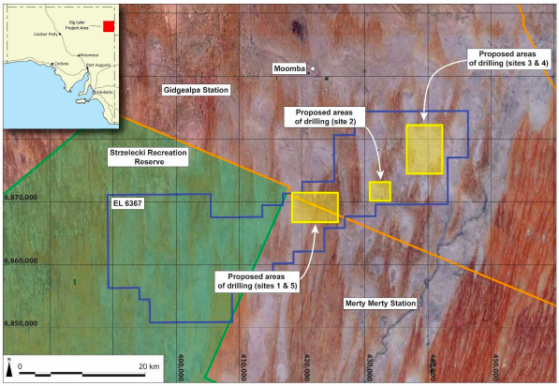After spending the past year interpreting publicly available 2D/3D seismic data, Alligator Energy Ltd (ASX:AGE, OTC:ALGEF) is ready for the hunt for uranium at the Big Lake Uranium Project in South Australia’s Cooper Basin as early as the first quarter of next year.
The ASX-listed company is working on obtaining cultural heritage clearance after agreeing to heritage protection and employment commitments with the Yandruwandha Yawarrawarrka Traditional Landowners Aboriginal Corporation (YYTLOAC).
Subject to rig availability, Alligator is targeting a drilling program of up to 45 holes averaging 140 metres in depth to test its mineralisation model on a number of drill fences to set the foundations for a more target-driven future drilling program.
Proposed drill sites for 2024.
Well-placed for execution
“We have spent the last year methodically interpreting the seismic data that is publicly available from previous work done by the oil and gas companies operating in the Cooper Basin,” Alligator chief executive officer Greg Hall said.
“This approach was viewed as a cost-effective method of identifying areas across our tenement package that display the right attributes for an exploratory drill program.
“We are now well-placed to execute on our first on-ground work program.
“At the same time as undertaking the large technical desktop exercise, we took the opportunity to meet on multiple occasions with the board of the Yandruwandha Yawarrawarrka Traditional Landowners Aboriginal Corporation to explain our exploration strategy and agree mutually acceptable terms for an NTME (Native Title Agreement for Mineral Exploration).”
Comparable to Kazakhstan uranium province
Alligator secured first-mover status for targeting a conceptual REDOX-controlled ‘roll front’ uranium mineralisation model in the Cooper Basin in December 2021.
The geological setting and scale of the Cooper Basin is comparable with the giant Chu-Sarysu Basin/Uranium Province in Kazakhstan, which produces 40% of the world’s uranium using in-situ recovery.
The 2D/3D seismic datasets were interpreted in conjunction with petroleum well lithological logs to construct an exploration model across the eastern half of EL 6367, which were then used to generate targets for the forthcoming drill program.
Alligator will focus its Big Lake exploration strategy around source rock and migration of uranium-bearing fluids into shallower parts of the Cooper Basin stratigraphy, among others.
Read more on Proactive Investors AU
